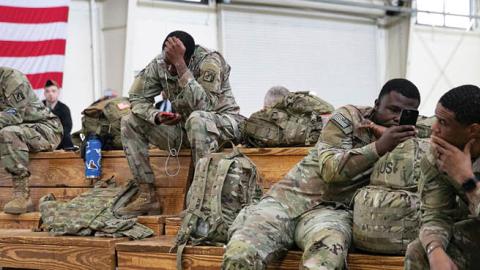The Biden administration failed to deter Russia from its second invasion of Ukraine. Like his predecessors in the White House, U.S. President Joe Biden went to great lengths to placate and reassure Russian President Vladimir Putin in return for stable relations. Biden defied Congress when he refused to sanction the Nord Stream 2 pipeline, unilaterally extended U.S. adherence to the New Strategic Arms Reduction Treaty without reciprocation by Russia, and honored Putin with a bilateral summit during his first overseas trip. As Putin amassed his troops on Ukraine’s borders, Biden pulled U.S. naval forces out of the Black Sea, refused to send additional weapons to Ukraine, enumerated everything the United States would not do to help Ukraine defend itself, and evacuated U.S. Embassy staff and military advisors. More broadly, the administration proposed a real cut to the defense budget; sought to reduce the role of nuclear weapons in U.S. defense strategy; restricted U.S. production capacity for oil, gas, and refined products that might have displaced Russian supplies; and signaled its willingness to overlook Russian and Chinese aggression in exchange for hollow pledges of cooperation on global issues such as climate change. After surrendering Afghanistan to a terrorist organization and conducting a humiliating retreat from Kabul, the administration’s attempts to deter the Russian invasion with threats of punishment were simply not credible.
Deterrence, however, does not disintegrate overnight. Contrary to the narrative of U.S. belligerence and imperialism that has been impressed on countless university students, the United States has, since the end of World War II, largely pursued a policy of restraint despite its considerable military power. Unlike other superpowers, it has not sought territories or treasure—on the contrary, it incurred considerable expense to foster a peaceful international order where other nations could thrive. Under the belief that a market economy, normal trading relations, and a democratic wave would foster liberal democracy everywhere, Washington even sought to elevate, embrace, and enrich its former Cold War enemies. From the World Bank to the International Space Station, the World Trade Organization to the Paris Agreement, Washington welcomed Moscow and Beijing into Western institutions—in other words, into the order Washington had previously tried to keep them from tearing down. Seeking to partner with Moscow and Beijing in the pursuit of global prosperity and a peaceful planet, Washington bridled its power by undertaking a generational drawdown of military forces and capabilities. Indeed, global prosperity grew and the number of democracies in the world steadily rose. As conviction rose in Washington that both China and Russia had transformed from adversaries to partners, U.S. restraint seemed a rational choice.
However, restraint was not reciprocated. As the United States reduced its defense spending to the lowest share of GDP since 1940, Russia and China embarked on the largest military modernization and expansion programs their countries had seen in generations. They bullied their neighbors (or in Russia’s case, attacked and occupied them), corroded the institutions they joined, and sought to eliminate their citizens’ liberties. U.S. restraint was interpreted as weakness. Ignoring these menaces has now led the West to the most dangerous precipice since the depths of the Cold War.
Even before the Berlin Wall fell in November 1989, Russian and Chinese militarism and belligerence were evident. In June of that year, Chinese tanks put down peaceful protests in Beijing’s Tiananmen Square, killing thousands of people. In late 1995 and early 1996, Beijing tried to intimidate Taiwan in the run-up to its first democratic election, firing missiles into Taiwanese territorial waters. In April 2001, a Chinese fighter jet rammed a U.S. reconnaissance aircraft in international airspace, forcing the naval airmen into an emergency landing in China, where they were detained for 10 days. Moscow engaged in two brutal wars against Chechnya and launched an assassination campaign against political opponents that continues to this day. In 2004, the Kremlin nearly killed then-Ukrainian presidential candidate Viktor Yushchenko in an attempt to secure victory for its preferred candidate. In 2006, a Russian agent poisoned and killed Alexander Litvinenko, a former Russian spy who had defected, and Anna Politkovskaya, an investigative journalist, was assassinated for opposing Putin’s wars. From the killing of Boris Nemtsov, a liberal critic of Putin, in 2015 to the poisoning and incarceration of dissident Alexey Navalny in 2020 to the most recent imprisonment of Russian opposition politician Vladimir Kara-Murza, Putin and his thugs have worked tirelessly to extinguish any criticism of, let alone challenge to, his iron rule.
Washington still did not waver from its predisposition toward restraint. Even after Putin made plain his goal of undermining the United States and the West at the 2007 Munich Security Conference, the U.S. military drawdown from Europe and Asia continued. The United States welcomed Russia into the G-7 in 1998, turning it into the G-8. China and Russia became part of the G-20 in 1999 and the World Trade Organization in 2001 and 2012, respectively. Putin’s 2008 invasion of Georgia was even rewarded with a positive “reset” of relations. The 2010 U.S. National Security Strategy called for a “stable, substantive, multidimensional relationship with Russia, based on mutual interests” and sought “Russia’s cooperation to act as a responsible partner in Europe and Asia.” Similarly, even as Chinese ships began clashing with those of their neighbors, even as China built and militarized 27 artificial islands and other outposts in the South China Sea, and even as Beijing claimed sovereignty over the sea and established air and sea superiority in an area where one-third of global trade passes, Washington remained withdrawn. The 2015 U.S. National Security Strategy “welcome[d] the rise of a stable, peaceful, and prosperous China” and sought “to develop a constructive relationship with China that delivers benefits for our two peoples and promotes security and prosperity in Asia and around the world.”
Instead, the two autocracies’ belligerence has only expanded. In 2014, Russia invaded, occupied, and annexed parts of Ukraine, initiating a long war it has now expanded. The following year, Russian troops propped up the murderous dictatorship of Syrian leader Bashar al-Assad, and soon thereafter, Putin sent his private mercenary army, the Wagner Group, into Libya. In 2016, Russia interfered in elections in Europe and the United States, exploiting domestic political divisions to sow discord and mistrust in the democratic process. Not to be outdone, the Chinese Communist Party (CCP) launched a genocide of its own citizens, imprisoned 1.8 million Uyghurs and other ethnic minorities in concentration camps and forcing them to undergo compulsory sterilization, forced labor, medical experiments, mass rape, torture, renunciation of their religious beliefs in favor of the Communist Party, cutting and selling of their hair, and organ harvesting. In 2020, Beijing cracked down in Hong Kong in direct contravention of the “one country, two systems” policy it had committed to by international treaty. Chinese soldiers also attacked Indian troops across their disputed border, initiating skirmishes leading to several dozen deaths. As if that was not enough, Beijing’s deceit, dishonesty, and dissimulation about the nature and origin of COVID-19 helped transform a local and possibly containable outbreak into a horrific global pandemic that has cost more than 15 million lives so far.
Russia and China were emboldened, in part, because the United States undertook the greatest drawdown of military power since the collapse of the British empire. In 1990, the U.S. military had about 266,000 service members stationed in Europe; by the end of 2021, it was only about 65,000 service members. In 1989, the U.S. Army had 5,000 tanks permanently stationed in West Germany alone; by 2014, there were zero on the entire continent. In 1990, the United States had 5,000 nuclear bombs forward deployed in Western Europe; today, it has around 150 nuclear bombs. Until the 2014 start of Russia’s war in Ukraine and despite NATO enlargement, not a single U.S. service member was permanently stationed farther east than during the Cold War. In Asia, where the Chinese People’s Liberation Army has more than 2 million ground force personnel and the Chinese navy is now the largest in the world, the United States’ active-duty Army has been cut by one-third since 1990. The U.S. Navy has 40 percent fewer sailors in Asia and will soon have only half the number of active warships it had stationed there in 1990. In 2019, China conducted more ballistic missile tests than the rest of the world combined. Recent reports show that China is expected to quadruple the size of its nuclear arsenal by decade’s end.
The policy of restraint continues to limit the U.S. defense budget. At the close of the century, China and Russia together spent 13 percent of what the United States spends on defense. Today, that number is 67 percent. Whereas U.S. defense spending fluctuated between 4.5 percent and 11.3 percent of GDP during the Cold War, Biden’s budget request for 2022 would have put defense spending at less than 3 percent of GDP—the lowest level since 1940, when Washington was still trying its best to stay out of international affairs. And while the White House’s recently released 2023 budget request contains a small nominal increase, rampant inflation makes it another de facto cut. By comparison, the Chinese defense budget—which is chronically understated by the CCP and does not include, for example, what local authorities spend on military bases or investments in research and development—grew 7.1 percent in 2021. And lest you be impressed by the still-ample size of U.S. spending, keep in mind that Washington spreads its military thinly, whereas Russia and China have a laser-like focus on dominating their neighbors and regions. U.S. armed forces are not only too small to deter or respond effectively to aggression, but the services have also incurred significant deferred modernization due to inadequate and unpredictable defense budgets as well as the U.S. Defense Department’s dysfunctional acquisition and procurement system. The United States is weaker, less secure, and less prepared to fight and win than at any time since the beginning of the Korean War.
Consequently, Putin launching the largest war in Europe since World War II should not have come as a surprise. For over three decades, Moscow and Beijing have eroded, flouted, mocked, and assaulted the order the United States and its allies built. Restraint encouraged that agenda as the United States and its allies dismantled the ramparts that had been vital to preserving peace and protecting the sovereignty of nations on the peripheries of two revanchist powers. And the drawdown continues—even as Russia continues its brutal invasion and China lays claim to Taiwan and the South China Sea. In its new national defense strategy, the Biden administration uses the term “integrated deterrence” to create the illusion that better coordinated policies can be substitute for modernized, ready, forward-positioned forces capable of operating at a sufficient scale to deter conflict and, should that deterrence fail, fight and win.
The United States must end its unilateral restraint vis-à-vis Russia and China and be realistic about the nature of the adversaries it faces. First, the United States must rearm, and the defense budget must increase. It must pay for new capabilities that counter and exceed those China and Russia have invested in. The Joint Forces must be substantially bigger to deter Russian and Chinese aggression as well as be able to respond to multiple, simultaneous contingencies. In today’s dollars, achieving even the Cold War-era floor of spending 4.5 percent of GDP on defense would mean a $1.2 trillion budget. Second, the United States must end its diplomatic restraint. Where it can, it should counter Beijing’s and Moscow’s efforts to subvert and co-opt international institutions and turn them against their purpose. If some of those institutions are beyond rescue, the United States and likeminded partners should form new groupings to advance the originally intended values and principles. In these cases, new institutions should prove more resilient and effective than the current ones plagued by discord and corruption. The Biden administration must stop describing Russia and China as partners in arresting nuclear proliferation, combatting climate change, and curbing pandemics. Finally, the United States must end its economic restraint against the predatory practices and outright criminal behavior of the Chinese regime. U.S. policymakers should not tolerate violations of bilateral and international trade agreements, the use of forced labor and other inhumane labor practices, and supply chains that leave U.S. national security vulnerable. Free trade only works among free people.
Putin’s latest assault on the free world—and Chinese leader Xi Jinping’s threats to do so himself—have the capability of resuscitating Washington from its comatose policy of restraint. The longer the United States operates under the delusion that restraint will appease authoritarian regimes that have made their hostile intentions abundantly clear, Russia and China will become bolder and the risk of a catastrophic war—which Ukraine was the prelude for—will only grow. In a world created by U.S. restraint, democracy, prosperity, and peace are on the decline. As Putin’s brutal war has reminded the world, weakness is provocative. Strength is the best way to preserve peace and secure a better future for generations to come.
Read in Foreign Policy


















